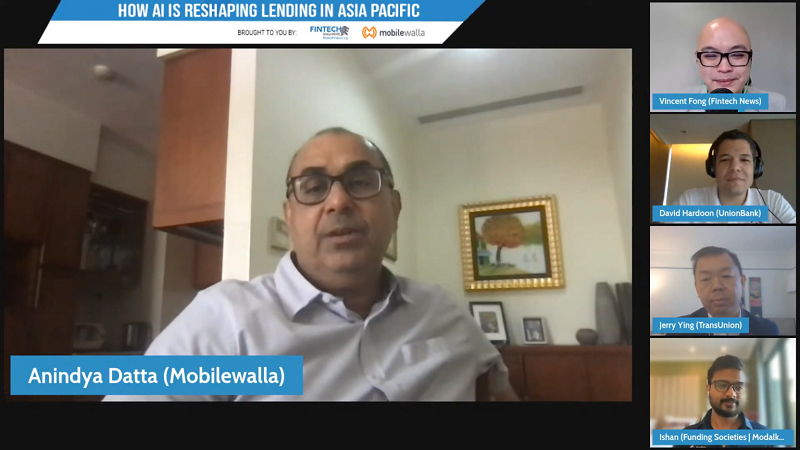Source: https://fintechnews.sg/62872/ai/how-are-asia-leading-lenders-leveraging-artificial-intelligence/
In Asia Pacific (APAC), artificial intelligence (AI) and machine learning (ML) are increasingly being deployed in credit and risk functions for improved credit assessment, credit scoring and fraud detection.
Moving forward, AI will no longer be an option for banks and financial institutions but rather a necessity, enabling them to meet rising customer expectations, tap new business opportunities, and address the rapidly evolving fraud landscape, data specialists and top finance executives said in a recent webinar.
During Fintech Fireside Asia’s latest panel discussion, C-level executives representing Union Bank of the Philippines, credit bureau TransUnion, lending startup Funding Societies and data solutions provider Mobilewalla discussed the state of AI adoption across APAC’s financial ecosystem, delving into how predictive modeling and ML are now being used in the lending process.
Improving financial inclusion
For Anindya Datta, Founder, CEO, Chairman, Mobilewalla, AI offers an opportunity to deliver innovative business models that can leapfrog traditional solutions and reach the unbanked, a potential that’s particularly relevant in Southeast Asia considering that more than 70% of the region’s adult population remain either unbanked or underbanked today.
“A major part of decision making in lending is around figuring out how likely a person is going to pay back and whether they will pay back in time. Why it’s so interesting In emerging markets, especially in APAC, is because the credit footprint is small [and a lot of people don’t] have credit scores,” Anindya said.
“In terms of technology adoption, ML is probably one of the biggest adopted framework technologies in fintech that are doing it to do credit worthiness.”
By relying on non-traditional data such as consumer mobility and average household phone price, AI can reduce information asymmetry for those who lack credit history, expanding credit availability to individuals whom creditworthiness can’t be measured using traditional metrics, Anindya said.
For Dr. David R. Hardoon, Chief Data and AI Officer, Union Bank of the Philippines, it’s all about “making lending more relevant,” supporting at-scale personalization, and realizing that banks are dealing with very different underlying cohorts and individuals with varied degrees of circumstances and necessities.

AI is about “the principle of hyper personalization, and really [focus on] understanding the specific customer in terms of the behavioral perspective, not from an ability of repayment but also from the ability in terms of capacity and necessity,” David said. “Understanding the usage and the moment of lives associated with that … [and moving away from] a lending point of view to more of a credit management perspective.”
Possibilities across the board
Ishan Agrawal, Group CTO, Funding Societies, Modalku, said that beyond credit scoring, AI and ML can also be applied to every single step along the lending lifecycle, starting with acquisition and application, to electronic know-your-customer (eKYC), fraud detection, underwriting and collection.
“AI really has applications all across the lending lifecycle,” Ishan said.
“In today’s world, if you are in the fintech space or doing lending in any shape or form, whether buy, now pay later (BNPL), credit card, mortgages, small and medium-sized enterprise (SME) lending, AI is going to be super essential, not just in credit scoring but across the board. It’s evolving very fast [and] I’m really excited about the next five years of what AI will enable.”

Ishan Agrawal, Group CTO, Funding Societies | Modalku
In customer acquisition, advanced analytics allow banks to deliver highly personalized offers and superior experiences ultimately leading to higher rates of conversion. This is made possible by getting a deeper understanding of each new customer’s path to the bank and getting an accurate view of a customer’s context and direction of movement.
In credit decisioning, AI and ML can be used to analyze broad and diverse data sets in near real-time, allowing banks to qualify new customers for credit services, determine loan limits and pricing in a fast manner, as well as reduce the risk of fraud by promptly detecting anomalies.
“At scale, finding fraud is a very nuanced problem,” Ishan said. “For example, [you need to look at] behavioral analytics, collect data on how a person is filling up an application, their speed of typing, pattern of typing, how long they take to complete an application. There’s no way that we can detect fraud other than with AI on these kinds of problems.”
Credit bureaus embrace AI and open banking
Besides fintech companies and incumbent banks, credit bureaus themselves have started actively leveraging alternative data and employing ML to produce better insights and expand their coverage.
In the Philippines, TransUnion Philippines launched last year CreditVision Link, a solution capable of credit scoring Filipino adults using traditional credit data and alternative data including telco data such as reloads, payments, mobile data usage, and device data.

Jerry Ying, Chief Product Officer, Asia Pacific, TransUnion
“In Hong Kong, we have a 85% coverage, … but in the Philippines, we only catch about 25% [of the population],” Jerry Ying, Chief Product Officer, Asia Pacific, TransUnion, said. “[With CreditVision Link,] instead of covering around 25 million of the [Filipino] population, now we can look at around 70-80 million [people]. That’s a major improvement.”
“This is where the need of AI is very important: to compensate the coverage of customers where some of the newer [customers] to the credit segment are not able to get lending.”
Another key technology TransUnion is actively exploring is open APIs. In the UK, the credit bureau has launched an open banking service that allows consumers to share their data with third parties when they are applying for credit. This aims to improve consumers’ experience by providing faster lending decisions and greater accuracy in risk assessment.
“We are starting to look at [introducing] that in Hong Kong,” Jerry said. “We are looking at how we can access data, … make use of AI to interpret the inquiry transactions and interpret things like an individual’s cashflow and income level, [and pulling that data directly from third parties sources.”
